Sunday 17th
March – Noses More or Less to the Grindstone in Whangarei
Having flown into
Auckland on 15th January and bussed back to Whangarei that day, we
busied ourselves to be able to leave the Whangarei Town Basin marina the next
morning and move Arnamentia a couple of miles downstream, dodging the shallows
and hugging the outsides of the bends in the river, to be off Norsands’ boat
yard at midday. Arnamentia’s 2.4m
draught is such that she can be lifted out there only at the top of a big spring
tide. Miss that and you might be
lucky to wait as little as a fortnight for the next opportunity. We had not appreciated, before electing
to go there, that they did not have a travel lift. That (and they do exist hereabouts)
would have made our coming out and re-launching easier and more flexible. Norsands’ method of hauling out using a
ramp, trolleys and a digger to tow the whole issue ideally suits catamarans
(shallow draught but fat). It’s a
touch clunky for a monohull and the process is a bit protracted. It can take up to half a working day to
get a decent sized monohull ashore, washed off and properly stabilized. But, it works, you need have no doubt
about how stable and secure your boat will be and everyone in the yard is very
professional, accommodating and friendly.
So, on balance, we have no regrets.
We hauled out to do the
sort of jobs you must do having sailed halfway around the world. There is plenty
of work that can be completed with a bit of time and application whilst afloat
somewhere calm. But, removing
underwater fouling and renewing the anti-foul paint, servicing seacocks and
other skin fittings, checking/servicing rudder and propeller bearings, replacing
sacrificial anodes and checking the integrity of the underwater hull material
protection system can’t be done that way.
Then there’s the stuff you never knew about until you stumbled upon
it. It’s like the rot you
discovered whilst restoring that dream house (or, vintage car) you decided to
buy.
So, we knew that we had
quite a lot to do under the waterline and that this was unlikely to be the stuff
of dreams. In addition, we’d
decided that, having raised the waterline around 3” before departing the
UK in late 2011, we’d materially
underdone it. The design
displacement of Arnamentia is some 14 tonnes. We had her weighed some years ago for
racing purposes and know her to weigh around 16.5 tonnes as currently fitted
out, but completely empty – no water, fuel or gas and not a loo roll, knife,
fork, spoon, sail, warp, sheet, pencil, chart, fender, anchor, chain, life raft,
dinghy or anything else that isn’t actually screwed down aboard. In current long-distance cruising mode,
she’s a great deal heavier than that.
All long-distance cruisers soon learn that, unless their anti-foul paint
extends several inches above the de facto waterline (forget de jure – that’s
well buried), they are in for a miserable time in pretty well any anchorage they
visit. Getting weed and scum off
the waterline is a pain. But, it
must be done. However, the more you
scrape the stuff off there, the more scratches are put into that area. Since there is no hope of getting wax
polish onto the hull that close to the waterline whilst the boat is afloat, that
makes the job for weed in colonising the area substantially easier. So, you’ll repeat the process ever more
frequently. We’ve been there, done
that and didn’t enjoy it. So, we
decided to have the waterline raised by a further 3”. Doing this is neither trivial nor cheap
unless you want a bodge job and to lose your boot top (the coloured line that
lies atop your anti-foul). We
hesitated about the expense of reinstituting the boot top above a raised
waterline. We were left in no doubt
about Arnamentia’s feelings. Given
that we had not consulted her before overloading her disgracefully, it was up to
us to sort it out properly. We
might be Darby and Joan but she wasn’t a bag lady.
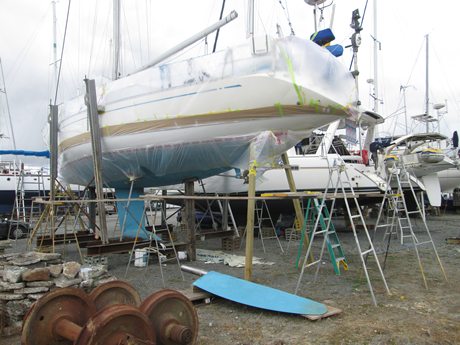
All masked up, old boot
top over-painted. Ready for the new
one.

Nearly there now with the
boot top. But, what’s the rudder
doing there?
Shortly having come out
of the water and whilst we were discussing the work we wanted done with the yard
manager, Peter Palmer, he gave the rudder a bit of an exploratory waggle. As you do. This was not good news. It shouldn’t have been possible to
waggle it much in its bearings but unfortunately it was. So, it needed to be dropped and seen
to. For a time it looked as though
we might have to dig a hole in the extremely hard ground with a pick axe to
allow us to drop it far enough. But
in the end that proved unnecessary – we just made it with the boat standing on
her keel on the cradle in which she was to remain whilst out of the water. Pity really; Jon was rather looking
forward to re-establishing contact with the kind of entrenching tool with which
he’d last had an intimate relationship at least 30 years ago as a forward
observation officer in the Royal Artillery.
Rudders on boats are
supported, suspended and enabled to rotate freely in a variety of ways. Arnamentia’s rudder is a big spade,
unsupported by a skeg, on a 5” diameter stainless steel shaft. Within the hull
it is supported by two bearings about 30” apart. Each bearing comprises two races mounted
one above the other along the shaft.
Each race within each bearing has around seventy 50mm x 6mm steel
rollers. Given the relatively short
lever arm between the bearings and the size of the rudder, it’s clear that those
rollers need to be extremely resilient.
So, brief flirtations with ideas around changing the design for some
solution based on plastic were soon binned in favour of sticking with the
original design but finding out what had gone wrong. One look at the rollers in the
lower bearing once we’d dropped the rudder was enough to establish that many
were deeply unhappy and in pitiful condition.

Not wholly happy holey
rollers. Wrong grade steel
evidently.
There was quite a lot of
contradictory advice to be had about all this. It was evident that the perished rollers
were not 316 grade stainless steel (316 SS). Extraordinarily, within the bottom
bearing, which has sea water washing through it, there was a mixture of 316 SS
rollers and those made of something else.
Er, no, we don’t quite know why either. Since this something else was slightly
magnetic, it might have been another grade of SS or chromed steel. But, whatever, it was clearly not the
right answer and hadn’t enjoyed being in close company with a slightly different
grade of steel whilst submerged in seawater (well, whaddaya know?). Eventually, Nautor Swan were able to
confirm that the right material was, much as we’d guessed by then, 316 SS. Until they’d done so, there had been
much tooth-sucking by observers in our vicinity. 316 SS roller bearings on a 316 SS
shaft? Whoa! You’ll get galling (whatever that
is)! Then you’ll be in real
trouble. Moreover, you can’t just
cut up 140 or so lengths of 6mm 316 SS rod to make the lower bearing rollers –
bearings have to be machined to fantastically fine tolerances. And so on. And so forth. Actually, the truth is that bearings in
machinery whizzing round at 3,000 rpm (so, 50 Hz – like, for instance, the
generators that produce your household electricity) do have to be ground to very
fine tolerances. The bearings on a
rudder are a different kettle of fish.
It’s a pretty agricultural kettle of grey mullet. Anyway, the chaps at Whangarei
Engineering, a few hundred yards down the road from the boat yard, did a great
job of sorting that out. The
lightness at the wheel now is remarkable.
Meanwhile, Jon learned a great deal about Arnamentia’s rudder bearings
whilst Carol learned quite as much about the controls on a fork-lift truck,
whilst refitting the rudder.

Take it easy now, girl. Then
anti-foul it please. Luvverly boot
top.
Next on the list of
important work to be done was the forehatch. The forehatch cover is a very large
(840mm/33” or so) smoked Perspex (or, whatever) sliding affair which is moulded
to a precise conical shape – cylindrical would be much too easy and cheap to
make; this is conical. We’d managed
to break it terminally on the way to Galapagos and had bodged a repair with
gaffer tape and silicone sealant.
That had seen us another 6,000 NM or so across the South Pacific to NZ
but it needed sorting. No problem –
Whangarei is a quite extraordinary place made up of hundreds of small
engineering-related businesses. So,
pretty well whatever it is you want made can be made locally. A new bespoke hatch cover was procured
easily and the job of fitting it given to the yard carpenter. “Easy as” – as they say here. The result is “Good as” – as they also
say here. “Cheap as” – no, nobody
said that! But, a “fair go” (which
they also say)? Oh,
yes.
It also became apparent
that the hinges on 4 much smaller opening (Goyot) hatches on the coachroof had
now so badly stiffened up after 20+ years that attempting to bring them back to
life was probably a mug’s game.
Anyway, support for Goyot products in this part of the world is weak
approaching pathetic and we also gather that they may have gone out of
business. However, some excellent
NZ-produced (Maxwell) hatches costing around £140 each (tax free), fitted the
holes in the deck so closely that it was a trivial issue for our professional
carpenter to sort out with a router.
Moreover, these seem much better designed than the Goyot originals. Vetus (a Dutch company) have now
acquired Maxwell and produce precisely the same hatches under the Vetus brand
name. But, they have done the sort
of thing that many big companies do on taking over small fry. Having acquired seriously good products
they changed the seals on them to make them use the same rubber stuff they use
on all their other hatches. But
they didn’t engineer the seals well enough at the outset. That’s a bit of a shame and a touch
careless. No problem for us; we
snapped up the last genuine Maxwell hatches in existence having rejected a
number of Vetus offerings. It’s
likely that by the time our hatch seals need to be replaced, Vetus will have
sorted it out.
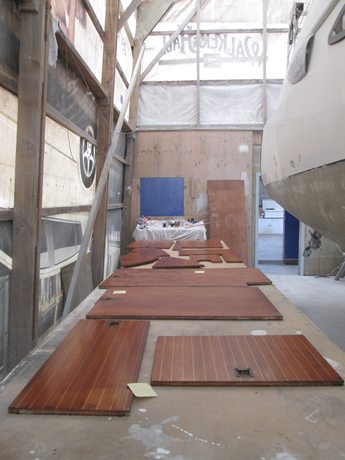
It’s not all below
waterline work – floor board varnishing production line, above. Each board had at least 3 coats applied
with sanding down between each one.
Top tip - next time do the boards after you’ve done the rest of
the sanding and varnishing on the wood work inside the boat.
Once all the painting and
so on had been completed we were finally in a position to anti-foul. We’ve got this drill off pretty well
pat. The important thing is to
start early in the day and be done with antifouling for the day by mid morning
at absolute latest. Otherwise the
air and hull surface temperatures are such that the stuff just won’t roll on
smoothly. No problem; three fairly
early mornings and we’d got three coats on at about 2 hours a coat. We’ve learned all about 9” professional
rollers and extension poles the hard way – some years ago. Before we did that it would have taken
us two or three times as long per coat with 4 “ rollers and step ladders we’d
have ended up cursing tacky anti-foul as the sun got itself out of
bed.
The clock counted down to
the planned launch date of 13th March. If we missed that, the next date on
which a big enough tide occurred outside a bank holiday or weekend was at the
end of April. So, missing it wasn’t
much of an option. Inevitably there
were one or two last minute panics – including one which required two 3”
countersunk bolts to be manufactured out of 3/8” pure copper rod the afternoon
before launch. These secured the
grounding plate for the SSB radio to the underneath of the hull. We noticed far too late that the
originals were badly corroded.
Well, Jon had only been looking at them on and off for 2 months whilst
the boat was out of the water, so had had almost no opportunity to notice the
problem. Obviously. There was absolutely no hope of
acquiring factory-manufactured replacements in time for a launch at 0800 the
next morning. Thankfully, the
boatyard owner, Murray, has a traditional yacht being re-fitted that has a fair
amount of copper rod being replaced.
He was kind enough to provide some old (nonetheless, perfectly good) rod
and Peter Palmer, the yard manager, performed the magic necessary to turn this
into the necessary bolts. Useful,
y’know, these guys.
The launch went exactly
as planned and we motored back to Whangarei Town Basin where we plan to spend a
few days before moving to a rather cleaner (much vegetation debris comes pouring
down the Hatea River) but less convenient marina at Marsden Cove – at the
entrance to the river and something like 40 minutes away from Whangarei by road
– parking Arnamentia up and going touring by car for a few
weeks.

Arnamentia – smart as a
carrot – being manoeuvred to the slip by the dump
truck
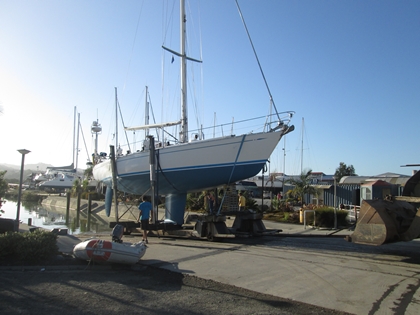
The moment of truth approaches – did we service those seacocks
properly?
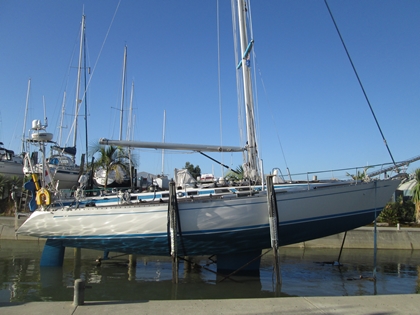
We’ll soon know
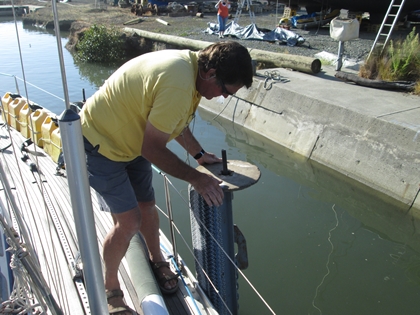
And now for the deeply technical bit – releasing the boat from the cradle
arms

Well, that all worked –
here’s the new bridge, under construction, en route to the marina and we haven’t
gone aground
One thing that has struck
us whilst out and about in the boat yard is the number of relatively young
catamarans looking seriously worse for wear after some moderately extensive
ocean work. Usually the problem is
with the way in which the hulls have been made. Often it seems that the construction has
been too light or inadequately ribbed or the GRP hasn’t been adequately
protected from osmosis. Hull thicknesses of around
5 or 6mm don’t seem that unusual.
That doesn’t seem a lot really for short-handed Mom’n’Pop ocean
passage-making, reef hopping, storm bashing and so on. Once the yards get their hands on these
boats and start exposing the issues, the results can look pretty horrific - to
us monohull sailors at least. We
have encountered some owners whose boats do not fall into this category – most
recently the owner of a South African built catamaran. Perhaps it’s more robustly built than
its largely French competitors.
But, we honestly wouldn’t know for sure. Nonetheless, I guess we’ll stick to the
monohull – moreover one that’s pretty sturdily built.
It is now Sunday morning
on St Patrick’s Day – and to remind everyone why Ireland is so green – it’s pouring with rain –
the first time for weeks, though it will need to carry on for days in order to
relieve the drought conditions which the North Island is
suffering.
Talking of green, whilst
Aranmentia was out of the water, we’ve lived ashore and so avoided having to
contend with the sort of internal chaos that exists in a boat undergoing
refit. An advertisement on the
boatyard notice board led us to a large open plan unit (Kiwi-speak for flat)
owned by retired architect, Harry and retired teacher Mary. They have a lovely, peaceful place,
hidden in the woods, by the Hatea River but enlivened by a great variety of
birdsong. Their beautiful garden –
in an acre sized section (Kiwi-speak for plot) was well stocked with fruit,
vegetables and herbs and with a good scattering of fruit trees. We’re well used to apples and pears but
to have peaches, figs and lemons growing outside the door was a treat. Mary was kind enough to invite us to
help ourselves to fruit and vegetables and Carol was able to make a rhubarb
crumble for the weekly boat yard Pot Luck BBQ. Returning from a day’s hard graft at the
yard, it uplifted the spirits to be welcomed by Lucy, the fox terrier, who
quickly sussed that Jon was always up for a game with her ball – although Lucy
had some difficulty with the notion that if she wanted the ball thrown she had
to let it be picked up by a human first.
Mary and Harry have been particularly kind to us. When we decided that Arnamentia needed
to be out of the water for longer than originally planned the flat had already
been booked by new tenants for the period we now needed. Amazingly, since they were planning 10
days away touring in their campervan, they said “Move into our house, and we’ll
stay away longer on holiday”! We were utterly spoiled by having
such a delightful space to spread ourselves out in, and there was a dishwasher,
too! It’s going to be hard to get
back to sea and pump sea water to rinse off dishes!
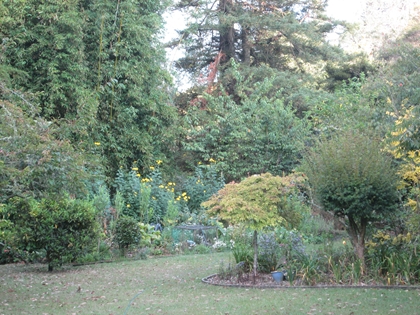
Looking towards the vegetable plot – leaves on the lawn heralding
the start of autumn.
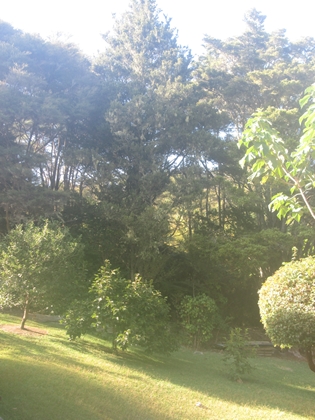
Peach and fig trees above the house
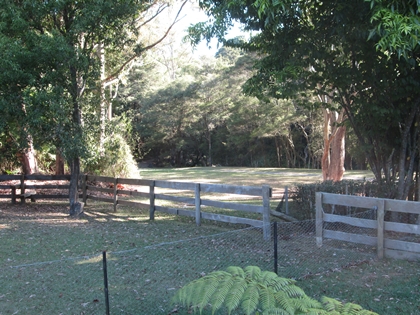
The view from the veranda – not a glimpse of the sea nor a boat in
sight!
Plans for the coming year
are in a state of deep flux.
Australia,
Indonesia,
Singapore,
Thailand (new teak deck?),
Burma? Well, why not? Thinking going
on.

